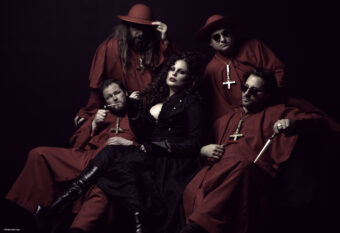Exhausted, spent, creatively tapped out…writing and recording new music while on the road isn’t easy. To be in a van and scribbling notes, sounding out hooks in between show after show, night after night, is many a band’s dream. But with the adrenaline of the live stage comes the fatigue of creating music so soon after the lights have dimmed. The dream becomes a nightmare.
Last year, The Black Cadillacs were recording a new self-titled EP and got hit with this very dilemma, a weary and stingy case of writer’s block. The nasty condition can hit any artist and stop up the flow of creativity, sometimes suddenly, and wholly unannounced. To combat this particular obstacle, the soulful rockers from Knoxville, Tennessee decided to take a detour from the road, and converge on a revered locale that has served as a beacon of inspiration for decades. They took a little trip to Memphis.
We tagged along as the five guys piled into their van and drove the 471 miles to The Birthplace of Rock ‘n’ Roll in search of motivation and ideas emanating from the city’s rich history: a lineage that runs the gamut from blues to soul to rock to Elvis, the King himself.
“Memphis is the kitchen. If you ever go to a really nice dinner party where does everyone want to be? The kitchen,” says Memphis based singer-songwriter Amy LaVere, when discussing the city’s roots and current status as a hub for hits in both the funk and soul genres. You can see for yourself in rich, immersive detail below, as the Black Cadillacs journey through the River City can be seen in the short film below that we’ve embedded:
https://youtube.com/watch?v=KB6xSn5SslY%3Frel%3D0
The boys’ first stop is Sun Studio, the legendary home of the rock ’n’ roll that was created in 1952 by rock and blues pioneer Sam Phillips (also founder of Sun Records). The two entities shared the same building on Union Avenue, cultivating masterful works from the likes of B.B. King, Johnny Cash, Carl Perkins, Jerry Lee Lewis, and the man himself, Elvis Presley.
“Just to be standing in that room where Elvis would stand, at the same microphone, it gave me chills,” says Black Cadillacs frontman Will Horton, getting a feel for the iconic room where classics like “That’s All Right” were recorded. As the birthplace of rock ’n roll and a distinct starting point that transported the Memphis sound to an eager radio audience across the country, Sun seemed like the best place for the group to start.
https://youtube.com/watch?v=yWgprZu4Hk4%3Frel%3D0
A quick trip downtown landed the band at Royal Studios, which began laying tape around the same time as Sun in 1957. Recording predominantly rockabilly acts at the time, house producer Willie Mitchell and a little-known Arkansas singer, Al Green, proceeded to help craft the world-renowned sound of Memphis Soul out of Royal. The studio to this day has continued to pump out major hits, with Mark Ronson recently utilizing the space to record his smash, #1 hit “Uptown Funk” with Bruno Mars and current house producer Jeff Bhasker. Memphis, it seems, is playing as vibrant a role in the national music scene as ever before.
A swing through what is now the Stax Museum, once home to Stax Records, continues the story of Memphis Soul with a behind-the-scenes look its driving force: faith and respect for history. Basking in the glow of the Hammond organ that Booker T. used when recording the “Green Onions”, the Black Cadillacs head through the rest of the label’s former home to uncover the various nooks and crannies where artists like Otis Redding and Wilson Pickett created their magic. That magic is still pushing the city’s scene to innovate and build upon its heritage today, with the current incarnation of Stax being represented under Concord Records by artists like Angie Stone, Amy Lavere, Ben Harper and Leon Ware.
https://youtube.com/watch?v=NfdPNMaBWI0%3Frel%3D0
“Memphis’ music scene has never left. It’s the people and that ‘mmphh’ that gave it its original spark,” says Stax Collections Curator Levon Williams. “That spark is still here, and people should come get a chance to experience that.”
That same spark lit a fire under one Eric Friedl in the mid-1990s, inspiring the young label owner to release a scrappy, punk-influenced brand of garage rock from Memphis bands and others from across the world. This new sound included indie scene staples such as Ty Segall, King Khan & the BBQ Show, and the late great Jay Reatard, all having released seminal records on Friedl’s Goner imprint. The label also has a Goner record store that keeps the Memphis rock masses plugged in and flooded with the best of what’s new and what was, an essential stop along the Black Cadillacs search for what kind of new perspective Memphis can bring to a touring band.
https://youtube.com/watch?v=7vtVmvDd4Lc%3Frel%3D0
Any rock that Friedl continues to put out, or any rock ‘n’ roll in general, has Elvis Presley’s fingerprints on it… and so the band knew it was necessary take a trip through The King’s former massive abode. His estate is, to this day, a monument that more than 600,000 people visit a year. “Graceland” as a National Historic Landmark, is a vision of what a young man from Memphis with not much more than a guitar and drive can make for himself. “When you really think about it, it’s mind blowing that rock, soul, country, and bluegrass… pretty much all forms of popular music were created here in Tennessee,” Hutton says as the guys dive into an enormous meal at Gus’s Fried Chicken.
With each stop of their journey swirling creatively in their minds, The Black Cadillacs hunkered down in Ardent Studios to put all their fresh Memphis inspiration into the recording of a new track. With Led Zeppelin and Big Star amongst the studio’s storied clientele, the band found an entry point for tapping into the well of ingenuity that seemingly overflows from Ardent, Sun, Stax and Royal on such a regular basis.
“Being in that place makes you feel like you have to live up to a certain standard,” says lead guitarist Matthew Hyrka. “You cannot go into Memphis and bring something half-assed. It’s just not going to work.”





